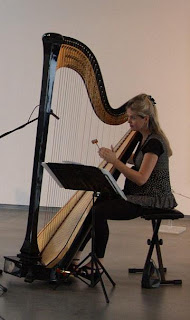Old
Town Square
July
11 & 12
 |
| Linka has kept cool in the face of daunting challenges. |
Franz
Kafka is alive and well in the Czech Republic. Or at least, the
absurdist world that he captured in novels and short stories is. For
proof, look no further than Bohemia Jazz Fest, which opens in Prague
tonight and plays in eight cities throughout the country, closing in
Prachatice on July 22.
The
festival is the creation of Rudy Linka, a Czech expat who left the
country in 1980 and went on to a great career as a jazz guitarist in
the United States. Prompted by a desire to bring the best of the West
back to his homeland, Linka launched the festival in 2005 on a unique
premise: World-class music presented in the visual splendor of
historic town squares, all for free. Featuring stellar performers
such as John Scofield, Stanley Clarke, Bill Frisell, Ralph Towner,
Roy Haynes and McCoy Tyner, it turned out to be an enormous success,
attracting more than 70,000 visitors every summer and garnering
positive reviews in publications ranging from Michelin travel guides
to Downbeat magazine.
Any
country in Europe would give its figurative eyeteeth to have an event
like that. So when Linka came in March to finalize details for this
year’s festival, he was surprised to learn that the Prague stage
had been moved from Old Town Square to Ovocný trh
(fruit market),
the much smaller square behind the Estates Theater. Despite
the fact that BJF jams Old Town Square to capacity every year, it
took a month of meetings to get it moved back.
“I
personally talked to about 20 people,” Linka recalls. “Then we
had all our contacts talk to their
contacts.” One meeting was particularly memorable. “I made a
presentation showing all the places we’ve been written up, and
talked about how tradition is so easily destroyed in this country,
and we’ve started a new one, and why would we destroy it? The guy
said, ʻI
agree. But what’s wrong with the fruit market?’”
That
turned out to be only the first of many stumbling blocks put in his
way. After Culture Minister Jiří Besser
was forced to resign last August,
bureaucrats took advantage of the leaderless interim to remove BJF
from the top-five list of cultural events in the Czech Republic,
effectively canceling its funding and forcing Linka to reapply, like
any first-year novice. After many meetings, the festival’s standing
was eventually restored, along with its funding – at one-quarter
the previous level.
Then
there is the legal case that BJF has been embroiled in since last
summer, when a former colleague, Jan Nedved, decided to start his own
jazz festival by stealing Linka’s concept, name, website design
and, most importantly, biggest sponsor – ČEZ.
The South Bohemia Jazzfest could never
match the original in talent, since many of the players come as a
personal favor to Linka. But even after BFJ secured an injunction
against the imposter, which Nedved has ignored, ČEZ
switched its financial support (said to be
in the neighborhood of 5 million Kč)
to him. “We can’t support two jazz festivals,” a company
spokesperson told Linka.
The
latest, though surely not the final, insult came as the stage was
being assembled on Old Town Square this year. It’s all backwards.
Instead of facing out from the Týn Church
side, it’s been moved across the square
and hemmed in by rows of sausage stands, severely reducing the space
where people can stand to watch the bands. Linka saw that plan some
weeks ago, explained that it wouldn’t work, and was assured that it
would be changed back to its original configuration.
So
he deserves a ton of credit for not throwing a fit when he walked
onto Old Town Square on Wednesday morning this week. Instead, he
looked around calmly and wondered, “Who is this benefiting?” It’s
tempting to think that some money changed hands and vendors or
restaurant owners will profit from the new arrangement. More likely
the bureaucracy, stymied in the short term, is sending Linka a
long-term message: You really belong on Ovocný
trh.
Whatever
the case, don’t let the snafu stop you from taking in the festival,
which once again is offering major stars: Dave Holland in Plzeň,
Dee Dee Bridgewater in Olomouc, Trilok Gurtu in Brno, Joe
Lovano in České Budějovice. And headlining the
first night in Prague is probably the best jazz band touring
anywhere in the world this summer: Guitar wizard Mike Stern, bass
superstar Richard Bona, drummer Dave Weckl and sax player Bob
Franceschini.
Rest
assured that on nearby Franze Kafky square, a certain author will be
present in spirit, taking in the music and appreciating the absurdity
of it all.
For
a complete Bohemia Jazz Fest schedule:
http://www.bohemiajazzfestival.cz////?lang=en












